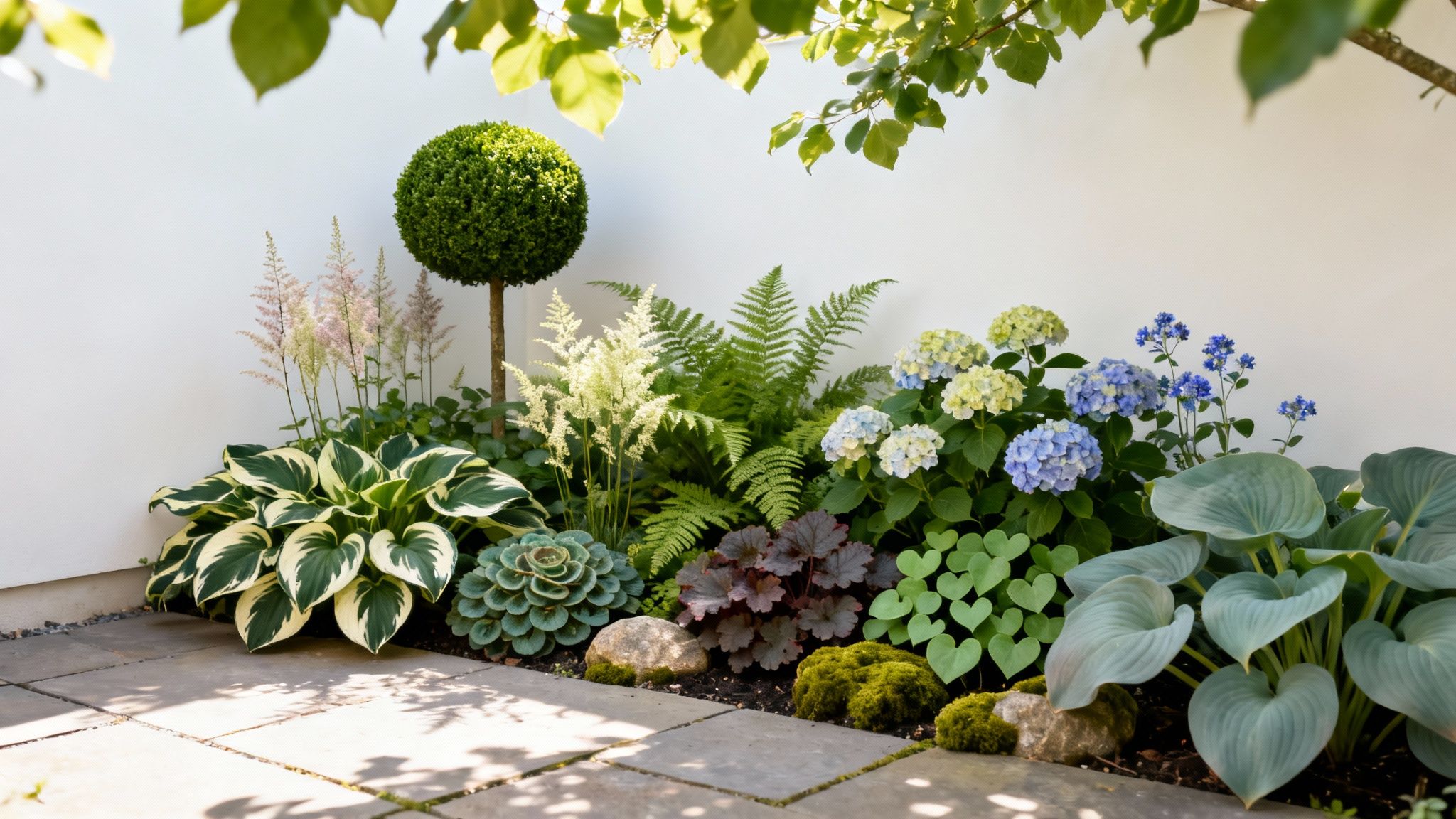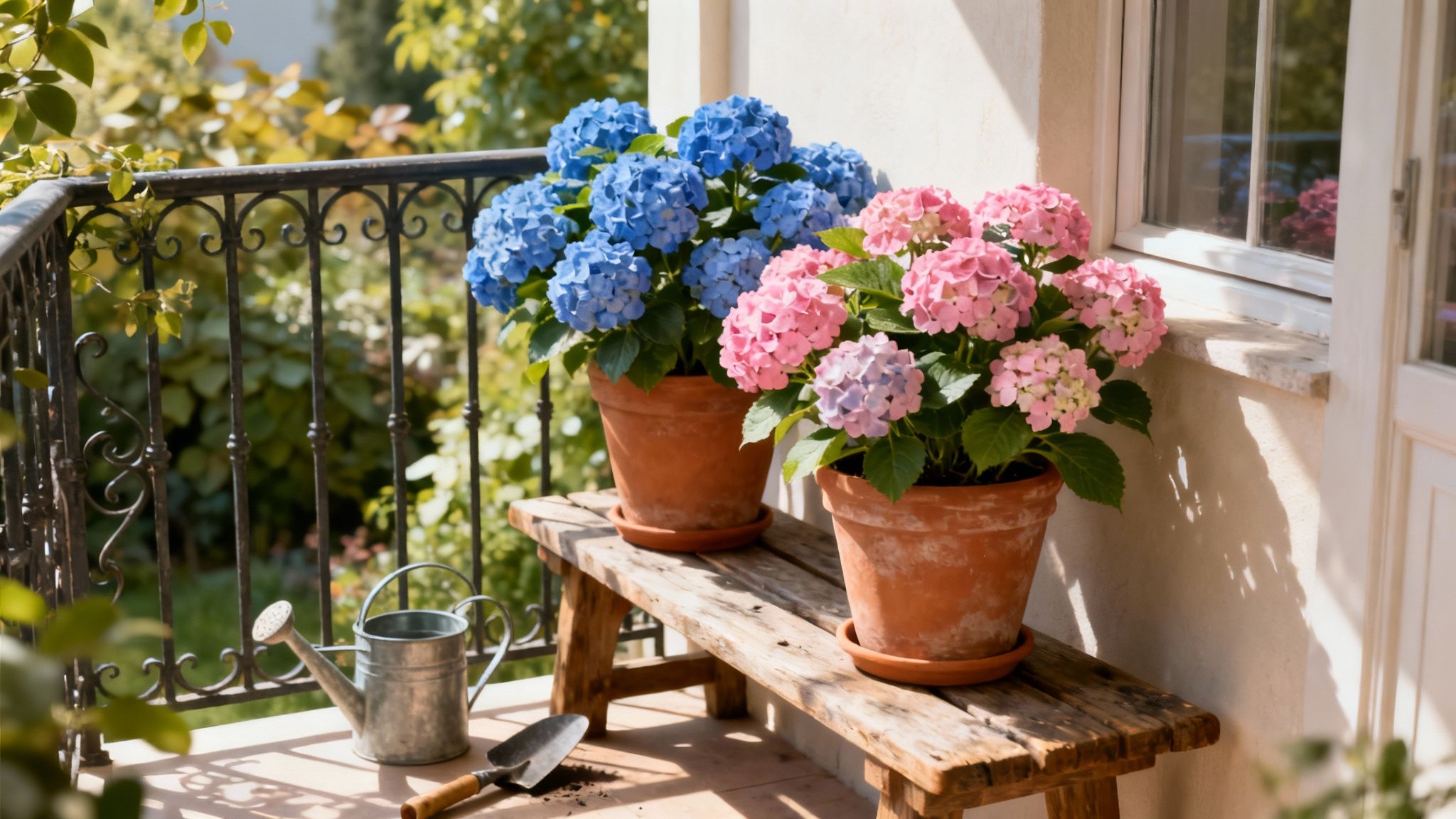Seeing one of your prized roses looking weak and droopy is a heart-sinking moment for any gardener. But don't panic. More often than not, it's a cry for help that you can answer with a few simple checks. Bringing a rose back from the brink usually comes down to getting the basics right: water, sunlight, and food.
A good, deep soak and a move to a sunnier spot can often work wonders. Think of it as immediate first aid for a plant in distress.
Where to Start: A Quick Diagnosis for Your Rose Bush
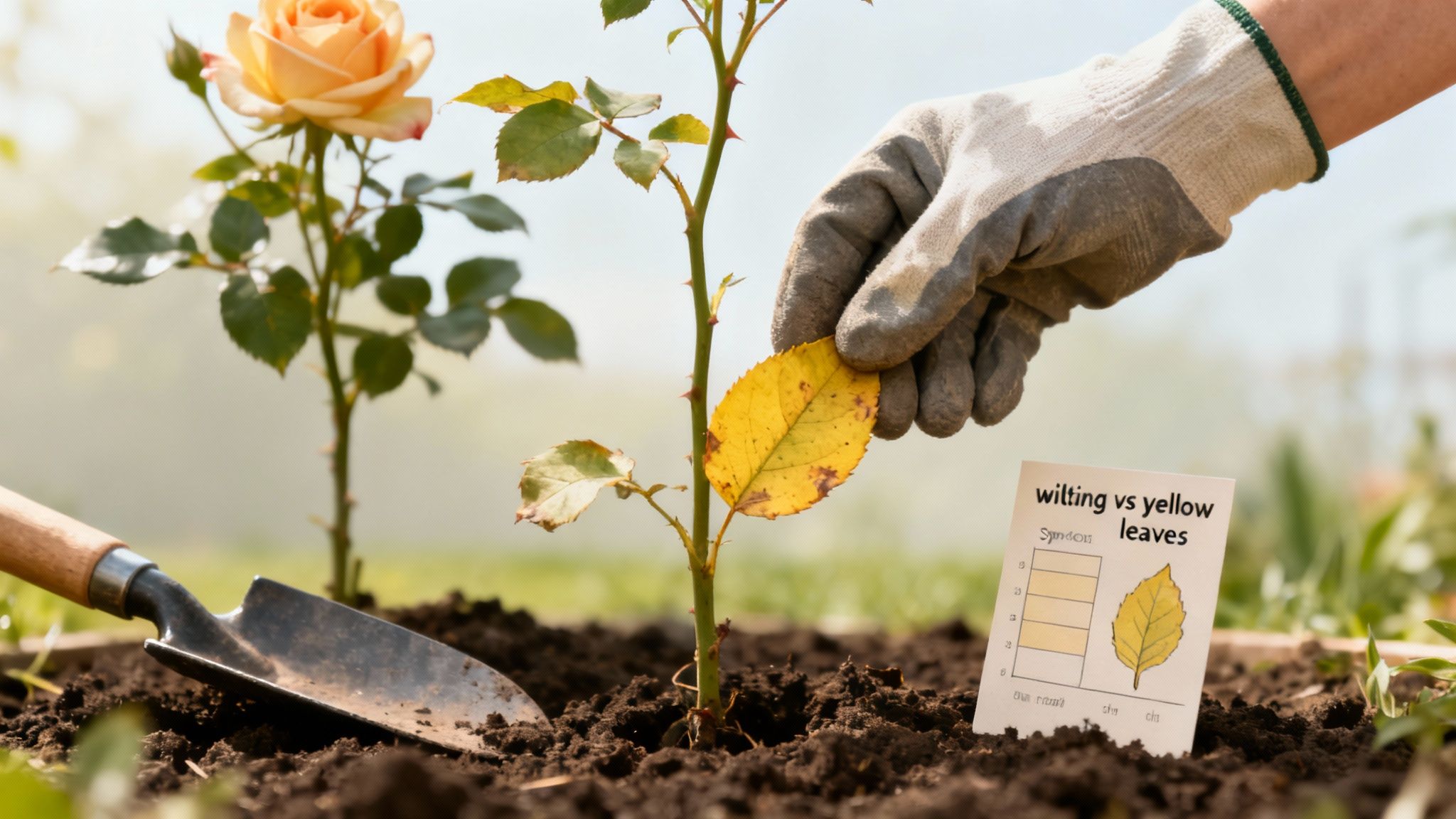
Before you start any major interventions, the first step is to play detective. Many common rose problems can be stopped in their tracks and reversed with simple, immediate actions. This is your emergency checklist for a plant that's clearly unhappy.
The most common reasons for a sad-looking rose are, thankfully, often the easiest to fix. It nearly always boils down to one of its fundamental needs not being met. Pinpointing the exact problem is the real key to reviving your rose and seeing it flourish again.
What's Stressing Your Rose?
When a rose starts to struggle, it's sending a clear signal that something in its environment isn't quite right. The usual suspects include:
- Dehydration: This is the number one cause of wilting. A rose's soil should feel consistently moist, a bit like a wrung-out sponge—never waterlogged or bone dry.
- Nutrient Deficiency: Are the leaves turning yellow, especially between the green veins? This is a classic sign of a lack of essential nutrients like iron or magnesium.
- Pest Infestations: Tiny insects like aphids love to suck the sap from fresh, new growth. This can cause leaves to curl and stunt the development of buds.
- Disease: Fungal problems like black spot or powdery mildew are particularly common in the damp UK climate and can quickly weaken the entire plant if left unchecked.
Pro Tip: A quick "scratch test" can tell you if the plant is still alive. Gently scrape a tiny section of bark on a main stem with your fingernail. If you see green underneath, it’s alive and kicking, with a great chance of recovery.
Matching the symptoms to the cause is the crucial next step. For example, sudden wilting on a hot, sunny afternoon screams "water issue," while a gradual yellowing and shedding of leaves might point towards a nutrient problem or a brewing disease. To stay ahead of these issues, our comprehensive gardening calendar provides seasonal tips to keep your plants thriving all year round.
To help you figure out what's wrong and what to do right now, I've put together a quick diagnostic chart.
Rose Revival Symptom Checker
This simple table will help you quickly identify what might be troubling your rose and what your first move should be.
By correctly identifying the issue, you can give your rose exactly what it needs to bounce back.
Giving Your Rose a Rejuvenating Prune
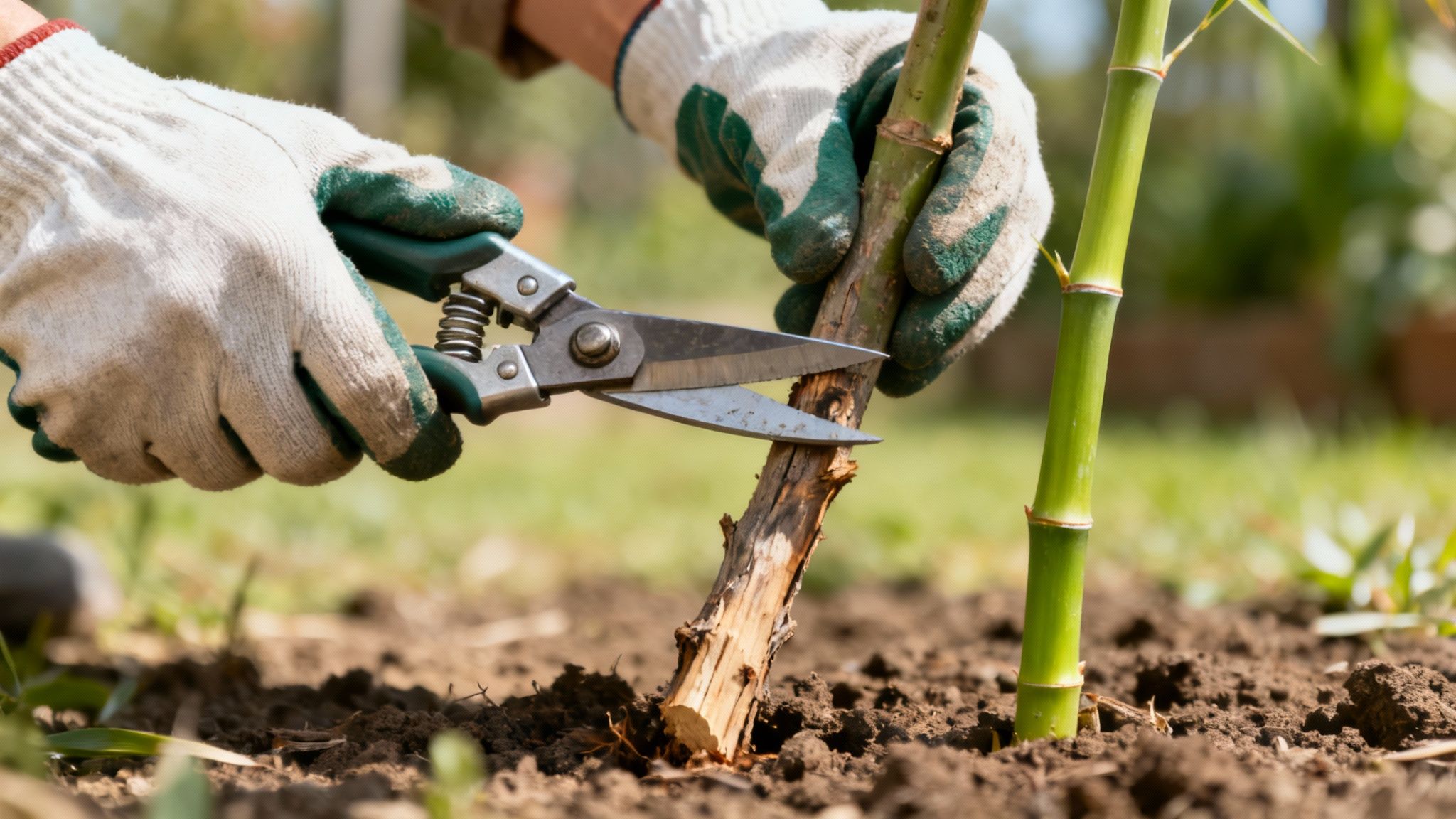
Grabbing the secateurs and cutting into a rose that's already looking sorry for itself can feel wrong, almost like you're finishing it off. In reality, a well-judged prune is often the best medicine you can offer. It’s a strategic reset, telling the plant to stop wasting precious energy on weak stems and instead push out fresh, vigorous growth.
Think of it as triage for your plant. A struggling rose is trying to keep everything alive—even the unproductive, spindly branches. By snipping away this dead weight, you’re freeing up resources for a proper comeback.
Knowing What to Cut
When you're pruning for revival, the main goal is to get rid of anything that's a drain on the plant's energy. I always tell people to focus on the "three Ds": dead, damaged, and diseased wood.
- Dead Wood: These stems are easy to spot. They'll be brown or grey, completely dry, and often snap without bending. If you scratch the bark, there's no hint of green underneath.
- Damaged Wood: Look for any branches that are cracked, broken from wind, or have been rubbing against another stem. These wounds are open invitations for pests and disease.
- Diseased Wood: Any stems with tell-tale signs of black spot, powdery mildew, or sunken cankers need to go immediately. Cut them back to healthy wood to stop the problem from spreading.
Getting this material out is the first and most crucial step. It tidies the plant, dramatically improves air circulation, and really gives it a chance to start over.
Pruning isn’t about punishment; it’s about preservation. Every cut you make is an instruction to the plant, telling it where to focus its strength for a robust and beautiful recovery.
The Best Time to Prune in the UK
In our climate, when you prune is just as important as how you prune. For the best results, you want to work with your rose’s natural rhythm.
Here in the UK, the ideal time to give most roses a hard prune is in late winter or early spring—usually March or early April, just as the new buds are starting to swell. This timing is perfect because the plant is about to burst into growth, so it will pour all its energy into producing strong new shoots from the fresh cuts.
According to a survey, a staggering 75% of British gardeners credit this timely pruning, along with proper feeding, for successfully reviving their roses each year. You can find more details on these gardening standards and practices.
For hybrid tea roses, a good rule of thumb is to cut them back by about a third to a half of their height. If your rose is severely neglected, this one big prune might be all it needs for the season. If it just needs a bit of a tidy-up, a lighter touch focusing only on the "three Ds" will do the trick. The principles are similar for other plants, as you can see in our guide on how to prune lavender. Take a good look at your rose and prune with confidence.
Watering and Feeding for a Strong Recovery
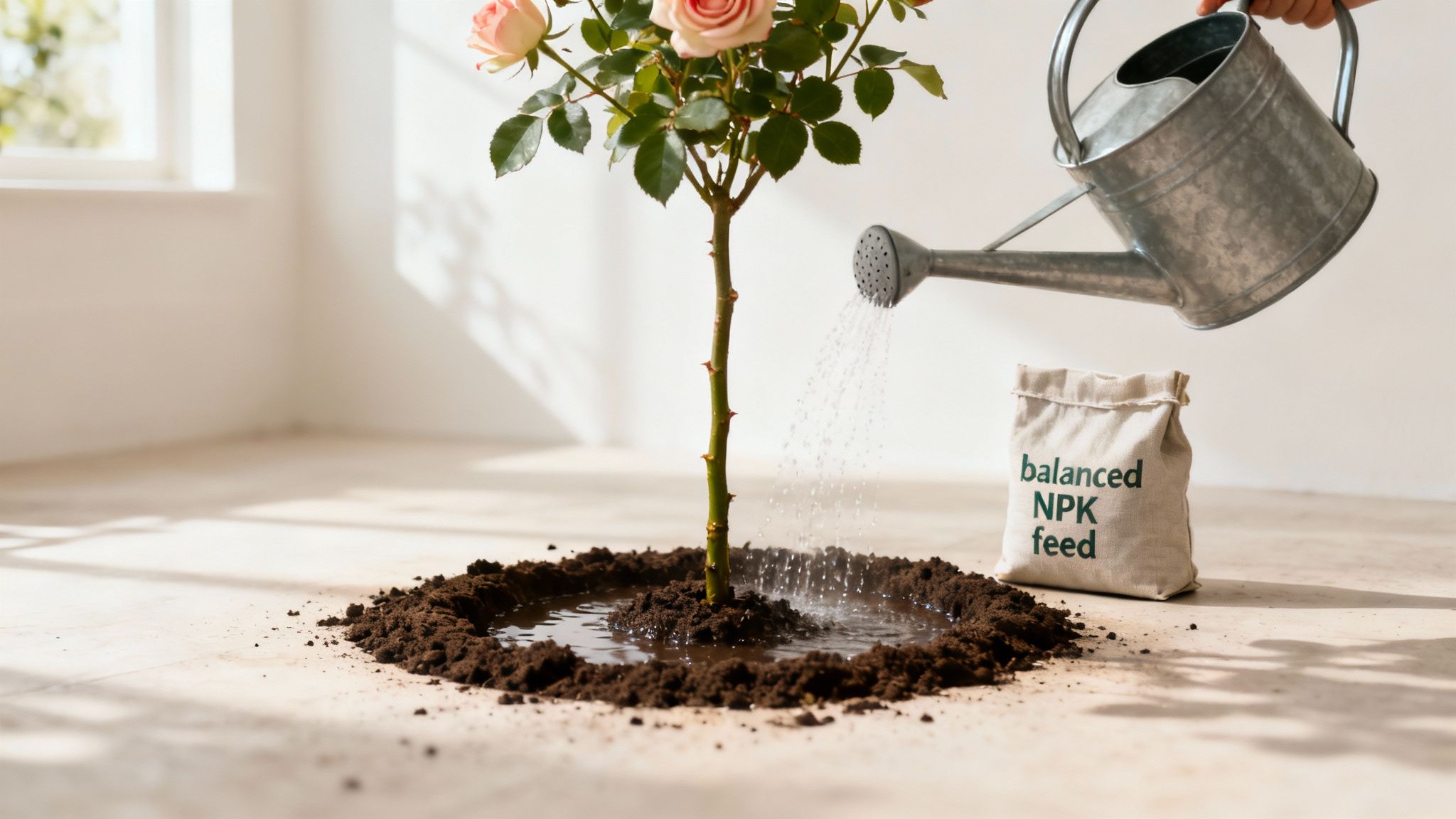
Once you've made those crucial pruning cuts, your next mission is to get the watering and feeding just right. This isn't just about giving the plant a drink; it's about providing the essential fuel it needs to bounce back, stronger than before. Forget the little-and-often approach some people suggest—a recovering rose needs a much more considered strategy to grow deep, resilient roots.
A daily light sprinkle might feel like you're helping, but all it really does is encourage shallow roots near the surface, leaving them vulnerable the moment the sun comes out. The real secret to reviving a struggling rose is to mimic a deep, soaking rain. This simple shift in technique trains the roots to grow downwards in search of moisture, anchoring the plant properly and making it far more drought-tolerant in the long run.
The Art of Proper Watering
So, how do you know when it’s time to water? The best tool you have is your own finger. Just push it about two inches into the soil near the base of the plant. If it feels dry at that depth, it’s time for a good soak. If you can still feel moisture, hold off for another day or two.
This simple check is your best defence against the two biggest watering mistakes:
- Overwatering: This is a classic rookie error. It can lead to root rot, where the roots essentially drown from a lack of oxygen in waterlogged soil. The confusing part is that the symptoms—wilting, yellow leaves—often look just like a thirsty plant, tricking gardeners into watering even more.
- Underwatering: This is what causes that classic, sad droop as the plant simply can’t get enough water up to its leaves and flowers. The soil around the plant will be visibly dry and might even be pulling away from the edges of the pot or the planting hole.
When you do water, make it count. Give your rose a long, slow drink right at its base, letting the water properly penetrate deep into the soil. I always find it's best to do this early in the morning. It cuts down on evaporation and gives the leaves plenty of time to dry before nightfall, which is a massive help in preventing fungal diseases like black spot.
A common pitfall is seeing a drooping rose and immediately reaching for the watering can. Always, always check the soil first. If it's already soggy, the wilting is a cry for help from distressed roots, not a sign of thirst.
Feeding for a Full Comeback
A weakened rose is a hungry rose, but you have to give it the right kind of meal. Think of it like a patient recovering from an illness—they need nourishing food, not a sugar rush. Plants rely on three main nutrients: Nitrogen (N), Phosphorus (P), and Potassium (K).
- Nitrogen (N) is all about fuelling leafy growth and giving the foliage that lovely, rich green colour.
- Phosphorus (P) is the powerhouse behind strong root development and, eventually, beautiful flowers.
- Potassium (K) is the all-rounder, helping the plant manage its water intake and fend off diseases.
For a rose that's in recovery mode, a balanced, slow-release fertiliser is your best friend right after pruning. It provides a steady, gentle supply of nutrients without overwhelming the delicate new roots. It's really important to avoid a high-nitrogen feed straight away; this can force a lot of weak, leafy growth at the expense of building a solid root system, which is what you really need.
Once you start seeing signs of healthy new growth, you can introduce a liquid feed or a specialised rose tonic every few weeks during the growing season for an extra boost. If you're keen on natural solutions, there are some brilliant recipes for homemade plant food that use ingredients you probably already have.
Patience is the name of the game here. Focus on building a healthy, robust plant first, and the gorgeous blooms will absolutely follow.
Dealing With Common UK Rose Pests and Diseases

Even with the best care in the world, the famously damp UK climate can roll out the welcome mat for a few unwanted guests in your rose garden. Pests and diseases are simply part of a gardener's life, but the real secret is spotting them early before a little nuisance turns into a full-blown crisis for your recovering rose.
Think of yourself as a plant detective. Learning to spot the classic signs of trouble helps you jump into action right away. It's this proactive mindset that's at the heart of knowing how to properly revive your roses.
Identifying Common Rose Problems
So, what are you looking for? In my experience, you’re most likely to bump into two types of culprits: fungal diseases that adore our damp conditions and sap-sucking pests that make a beeline for tender new growth. Each one leaves a very distinct calling card.
- Black Spot: This is probably the most infamous rose disease out there. You'll see dark purple or black blotches on the leaves, often with a tell-tale yellow ring around the edge. Before long, those affected leaves will drop, which can seriously weaken the whole plant.
- Powdery Mildew: This looks exactly like it sounds—a dusty white coating that settles on leaves, stems, and even the buds. It tends to appear when we get warm days followed by cool, damp nights, and it chokes the plant by hindering photosynthesis.
- Aphids: These tiny green or black insects love to party on new shoots and underneath leaves, sucking out the sap. An infestation usually causes distorted, twisted growth and a sticky residue known as honeydew.
The best defence is a good offence. Something as simple as giving your roses enough space for air to circulate is one of the most effective ways to stop fungal diseases from ever getting a foothold.
Effective and Gentle Treatment Options
Once you've got your culprit, you can plan your attack. I always recommend starting with the gentlest, most eco-friendly methods first. You'd be surprised how often simple cultural controls do the trick without resorting to anything stronger.
A sharp blast of water from the hose is often all it takes to send an aphid colony packing. If you’re dealing with a fungus like black spot, your first job is to meticulously remove and destroy any infected leaves. And whatever you do, never add them to your compost heap—that’s a surefire way to spread the spores around your garden. This kind of preventative care is vital for other flowers too; it’s a similar principle to follow if you find your peonies are not blooming as expected.
Using Organic Solutions
For problems that are a bit more stubborn, organic sprays can be a real ally. Neem oil is a fantastic all-rounder that works as both a fungicide and an insecticide. A simple homemade soap spray, just a few drops of washing-up liquid in a water sprayer, is also remarkably effective against aphids.
It’s heartening to see that despite a general dip in garden centre sales, people's love for ornamental plants is as strong as ever. While overall sales for gardening goods in June 2025 saw a drop of about 8%, the ornamental plant category, which includes our beloved roses, actually grew by an estimated 6%. It shows a real dedication to planting and reviving our gardens. Tackling pests is just part of that rewarding challenge, and it's what keeps our outdoor spaces healthy and beautiful.
Long-Term Care for Healthy and Resilient Roses
Bringing a drooping rose back from the brink is a fantastic feeling, but the real win is keeping it that way. The secret to a truly resilient plant that bursts with life year after year is shifting your mindset from emergency rescue to thoughtful, long-term care.
This is all about getting ahead of the game. Instead of simply reacting to problems as they pop up, you create an environment where your roses are far less likely to struggle in the first place. It’s about being a strategic gardener, not just a plant paramedic.
Creating an Annual Care Plan
A yearly routine doesn’t have to be some complex, rigid schedule. Think of it more as a gentle rhythm, giving your rose the right support at the right time as the seasons turn.
A simple plan can make all the difference. Here’s what I’d suggest focusing on:
- Seasonal Feeding: Give your rose a brilliant start in early spring with a slow-release granular feed. Once it's actively growing, a liquid tonic every few weeks from late spring to late summer will really encourage those beautiful blooms.
- Proper Mulching: This is a total game-changer. In spring, apply a thick layer of well-rotted compost or bark chippings around the base. This simple act locks in precious moisture during dry spells, keeps the weeds down, and slowly feeds the soil.
- Winter Preparation: Getting your plant ready for the cold is vital for its long-term survival. For some essential pointers, take a look at our guide on protecting your plants in winter.
Adopting a long-term mindset isn't just about reviving roses; it's about cultivating a garden that gets stronger and more beautiful with each passing year. Consistency is your most powerful tool.
Building a Stronger Garden Ecosystem
Looking beyond the basics, you can make your entire garden a healthier home for your roses. The best place to start is right under your feet: the soil.
Regularly working in organic matter like compost does wonders. It improves the soil's structure, helps with drainage, and boosts its nutrient content, creating the perfect foundation for a strong root system.
This focus on soil health is something we're seeing across the wider horticultural world. The growing demand for locally grown cut flowers has pushed growers to develop tougher varieties and better revival methods. Interestingly, this has led to a rise in domestic rose sales of roughly 15% between 2020 and 2023, with a real emphasis on soil health and natural disease resistance. You can dig deeper into these industry trends and their impact on flower cultivation.
Another great trick is to use companion plants. Popping in some lavender or marigolds near your roses can help deter common pests like aphids, all without reaching for a chemical spray. It helps create a balanced, self-sustaining little ecosystem where your revived rose can truly flourish.
Got Questions About Bringing Your Roses Back?
When you’re nursing a treasured rose back to health, it’s only natural to have a few questions. Every plant has its own personality, and the road to recovery can sometimes be a bit bumpy. Here are some quick, clear answers to the most common queries I hear from fellow gardeners.
You’ve already done the hard work of diagnosing the problem and giving your plant some TLC. Now, let’s clear up those last few uncertainties.
Is It Possible to Revive a Rose That Looks Completely Dead?
This is the million-dollar question, and the answer, thankfully, is often "yes." But you need to be sure. The best way to check for signs of life is with a simple "scratch test."
Take your thumbnail or a clean, sharp blade and gently scratch a small patch of bark on one of the main, thicker canes.
- See green underneath? Fantastic! That means there's living tissue inside. With a bit of care, your rose has every chance of bouncing back and putting out new shoots.
- Is it brown, dry, and brittle? That particular cane is dead. But don't throw in the towel just yet. Test a few different spots, especially lower down near the base of the plant, before you declare it a lost cause.
How Long Does It Take for a Rose Bush to Recover?
Patience, more than anything else, is your best friend here. How long it takes for a rose to revive really depends on what was wrong with it in the first place and its general condition.
For a straightforward problem like dehydration, you could see the leaves perk up within a few hours or a day after a good, deep soak. But for a rose that’s been seriously neglected, battling a disease, or cut back hard, you'll need to play the long game.
You should give it at least one full growing season to see strong, healthy new growth. The goal right now is to get the plant to focus on developing new leaves and sturdy stems, not flowers. The blooms will follow once it has rebuilt its strength.
Should I Use Chemical or Organic Treatments?
For the vast majority of common garden pests and diseases, starting with organic and cultural solutions is always the best bet. They’re not only effective but also far kinder to your garden's ecosystem and all the beneficial insects that call it home.
Before reaching for a strong chemical, try these approaches first:
- Improve air circulation by giving your plants enough space to breathe.
- Snip off affected leaves the moment you spot any trouble.
- Use gentle sprays like neem oil or a good insecticidal soap to tackle pests.
Think of chemical treatments as a last resort. They should only be used for severe, stubborn problems that just won’t shift with gentler methods. Remember, a healthy, well-cared-for rose is naturally much better at fending off problems on its own.



